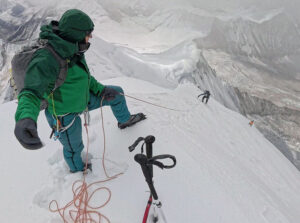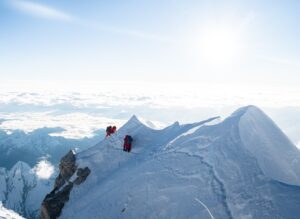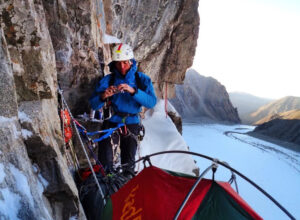Felix Berg believes that he has bagged the season’s only summit of Manaslu so far but he admits that he can’t be sure. He climbed alone in bad weather, summited in zero visibility and high winds, and endured an epic descent.
He told ExplorersWeb that it was impossible to check if he was at the right point. Berg briefly touched a rocky point at the end of a 45º slope, then turned around in the whirlwind.
“It was my Manaslu summit,” he posted on social media.
Back in Samagaon, the German climber elaborated to us about his climb.
Berg launched his summit push from Camp 2 at 1 am on April 18. After everyone else on Manaslu this spring had turned around because of too much snow, the first question that comes to mind is, what were conditions like for a solitary climber?

Snowshoe tracks in the snow. Photo: Felix Berg
Caught in the storm
“I used snowshoes to approx 6,900m,” Berg explained. “Interestingly, from that point, I found hard, generally very dry terrain, blue ice in some places. It was good to move quickly!”
From noon onward, the weather began to sock in. “First, wind clouds built around the summit, and there was nearly no visibility,” Berg wrote. “Cumulus clouds had also started to build up.”

Berg changed to crampons around 8:30 am at 6,900m. Photo: Felix Berg
By the time the wind rose and he was in a total whiteout, the climber decided he was too close to the goal to give up.
“I headed up as fast as possible to the rocky outcrop on the main summit,” he told us. “The last slope (from kind of a 3rd plateau) had nearly no visibility, and I reached a mainly rocky summit.”
On social media, Berg described a 45º slope under the summit ridge that led him to a big boulder. He could see nothing else.

Berg under the summit ridge in the whiteout. Photo: Felix Berg
“It was very windy, whiteout, and the weather had deteriorated quickly,” said Berg. “So I headed down immediately.”
Was Berg positive that he reached the main summit? And does it really matter?
The summit matters, but style matters even more
“Oh, it does matter,” Berg replied. “In those conditions, it was hard to judge. There was no place to climb higher in the 5-10m of visibility I had, and it was too stormy to search.
“The climb was a true adventure, a real natural mountain experience, and that’s more important,” Berg added.
He pointed out that he was not intending to break a record or climb a new route. It was just a personal achievement.
“It was a very special way to climb an 8,000’er,” he said. “I went solo and unsupported most of the time. I did use some fixed ropes, new ones between Camp 1 and Camp 2, and some old ropes that I found on the descent between Camp 4 and Camp 3.”
Berg didn’t use supplementary O2 or have any emergency oxygen on hand. He had to assess the risks and made decisions with little chance of help or rescue.
A rocky summit
Asked whether he thinks he reached the true summit, Felix Berg said, “I am positive regarding the timeline and the general location. Some locals who have climbed the peak in the fall spoke of a snowy summit, while I was at a partly rocky crest that led to a mostly rocky summit. I wonder if the summit of Manaslu might look different in spring and autumn.”
Indeed, historical summit pictures on Manaslu (check all the info here) show a mainly rocky summit in spring and a snowy peak post-monsoon. The summit of Manaslu was also bare rock when the latest summiters reached it in clear weather, below.

Tenjen Sherpa on the summit of Manaslu, Jan. 6, 2023. Photo: Alex Txikon’s team
We sent Berg the picture above and he replied: “That rocky tip in the winter picture looks similar, and I can remember the red rope. I think I used it to rappel three sections below C4 on it.
“But again, it is hard to be 100 percent certain, as since I had no visibility. Also, the descent occupied my mind completely. Getting down was really tough.”
Hard descent
“Tough” is a very mild way to describe his descent.
“Whiteout, 20 to 30cm of new snow, darkness, track blown over…a crevasse where I thought I would get stuck. I found my way out and followed a slightly visible track that led back to Camp 2, which I reached after 20.5h round-trip,” Berg recounted on Facebook. “I am happy not to be on Manaslu anymore.”
In addition to the conditions, Berg faced the added risk of being totally alone on the mountain.
“A team of two Japanese climbers and three Sherpas started the same day from Camp 2 to establish Camp 3 at approximately 6,800m,” Berg explained. “This was at the same time that I reached 7,450m near Camp 4. Then they returned to Base Camp. So both on the summit push and especially on the descent, I was completely alone on the mountain.”
Not over on Manaslu and Annapurna
Berg also noted that a Japanese-Nepali team (from Tokyo University) helped him open a trail from Camp 1 to Camp 2 some days before. They have not yet given up and are currently waiting in Base Camp to launch their own summit push if the weather allows.
Felix Berg hopes to summit another 8,000’er this spring.
“I am trying to get to Kathmandu as soon as possible, in order to join Adam Bielecki and Mariusz Hatala on Annapurna, although we are kind of running out of time,” Berg said.
The two Polish climbers are currently resting down the valley, in Tatotpani. They hope to launch a single push on Annapurna’s normal route. Their original plan to open a new route on the peak’s Northwest Face proved impossible because of poor conditions on the face. They were then involved in the miraculous rescue of Anurag Maloo from inside a crevasse, where he had been stranded for three days.






